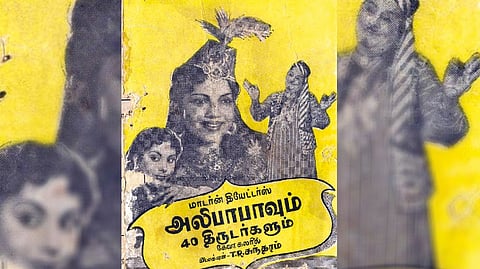

CHENNAI: In this series, we take a trip down memory lane, back to the Madras of the 1900s, as we unravel tales and secrets of the city through its most iconic personalities and episodes
One of the most popular collections of stories in the world of literature is the Arabian Nights (1001 Nights). The thousand stories are based on oral literature and have been reinterpreted over hundreds of years by Middle Eastern and European storytellers. Ironically, the three most familiar amongst them — Aladdin and his Wonderful Lamp, The Story of Sindbad the Sailor, and Alibaba were not a part of the original collection but added later when European story collectors assembled the tales.
Alibaba was added to the collection in the 18th century by its French translator Antoine Galland, who heard it from a Syrian storyteller. Since then, Alibaba has been widely retold and interpreted especially for children, from whom the more violent aspects of the story are often withheld. In Tamil, even before the story was filmed in its original form, a parody film was made by comedian NS Krishnan in 1941. But the posters of the hero astride a donkey failed to draw crowds to the theatre. NSK’s comical treatment of the film left a bad taste. The alien setting of Baghdad also deterred others from attempting to film it again.
Halfway through the 50s, a Hindi film called Alibaba Aur 40 Chor became a nationwide hit and TR Sundaram of Modern Theatres bought the Tamil rights to the film. Subsequently, his film studio decided to make Alibabavum 40 Thirudargalum with Alibaba as a swashbuckling hero rather than a harmless woodcutter. Sundaram felt the upcoming hero MGR was best suited for the role. The film, released in 1956 featured a climactic showdown of a sword fight between the hero and the villain.
The inhouse production design team designed fantastic sets, while Sundaram decided to shoot the feature as the first full-length Tamil colour film in Gevacolor. Until then, manually colouring a song or a few sequences was the practice. It was a laborious and resource intensive process, but evoked the interest of the audience. It was prominently mentioned on the film posters too, which was the case with movies all over India.
In 1953, GP Sippy (who in his long-career produced the legendary Sholay) went on to make Shahenshah, a Bollywood action and drama film, which was India’s first full length Gevacolor film. Interestingly, the film’s hero Ranjan hailed from Mylapore. Gevacolor was a colour motion picture process introduced in 1947 by an MNC called Gevaert in Belgium.
When a competing studio announced its version of the Ali Baba story to be released ahead of the Modern Theatres version, there was palpable tension in the air. However, Sundaram decided to give the first colour film in Tamil the treatment it deserved.
He spared no expenses as Baghdad was recreated on sets and Arabian costumes were stitched for hundreds of extras. The forty thieves of the story rode majestic stallions and galloped into the villages. The Mysore Reserve Police lent its horses for the film and when the 40 well-bred beasts thundered on screen, it stunned the audiences. Since the horses could not be moved out of the State of Mysore, two homogenous sets were erected — one in Mysore for the horseback shots and one in the Yercaud forests for other shots.
The story of a woodcutter who discovers the den of a gang of thieves and overhears the magic phrase for opening the entrance to the cave was tweaked to accommodate the skills of the actors. Though MGR played the hero, the villain portrayed by PS Veerappa and heroine P Bhanumathi as the slave Marziana found a great avenue to showcase their talents. Bhanumathi, who had been an actor for close to two decades, sang in her own voice and danced her way into the audience’s hearts.
Veerappa with his thunderous laughter, played such a fearsome King of Thieves that the audiences would hurl epithets at him in the cinema halls. His tearful family even exited the theater halfway. MGR and his elder brother Chakrapani played siblings in the film. MGR was also referred to as ‘chinnavar’ (the younger one) for a long time in Kollywood.
His newfound fame led him to clash with the studio too. In one dialogue, when Alibaba needed to swear in the name of Allah, MGR who had freshly embraced the rationalist ideology of Dravidian politics, refused to do so. But Sundaram stood his ground and convinced him to say his lines.
While MGR had a hard time juggling the shoot of Madurai Veeran and Alibaba, Sundaram could not wait. He hired a body double for MGR named Karadi Muthu and used him in the fight scenes and in a duet with Bhanumathi. Through slick cinematography, the makers refrained from focusing on the actor’s (body double’s) face. While none in the audience discovered the switcheroo, MGR took it personally and never worked with Modern Theatres again.
Sundaram felt there was no need to create new tunes for the songs and used the Hindi song melodies for the Tamil version as well. The songs were great hits and are still fondly remembered. Most people watching the film on a TV rerun today will miss one crucial fact. Waheeda Rahman, who is revered as a Bollywood legend, performed a dance sequence in the film for the superhit song Salaam Babu Salaam Babu.
— The writer is a historian and an author
Visit news.dtnext.in to explore our interactive epaper!
Download the DT Next app for more exciting features!
Click here for iOS
Click here for Android